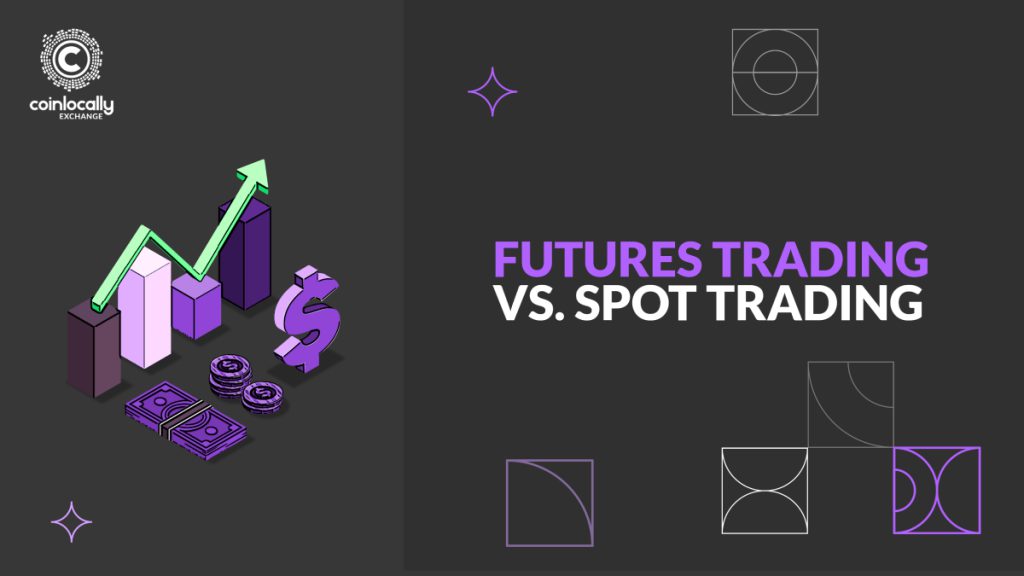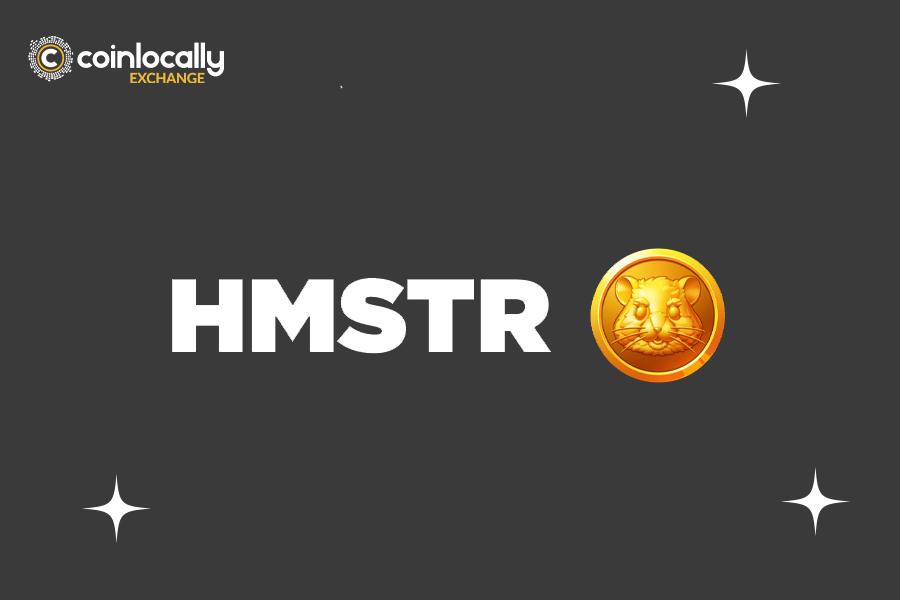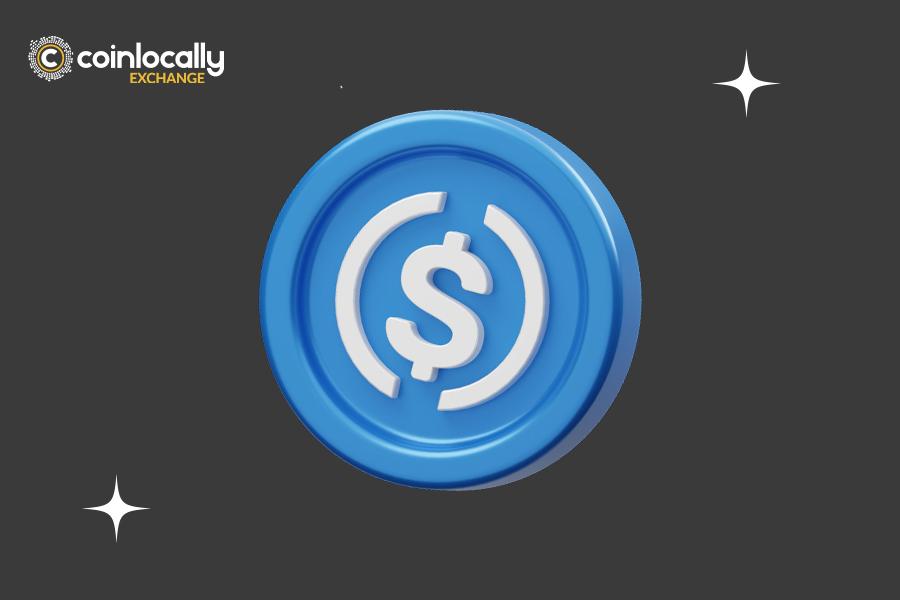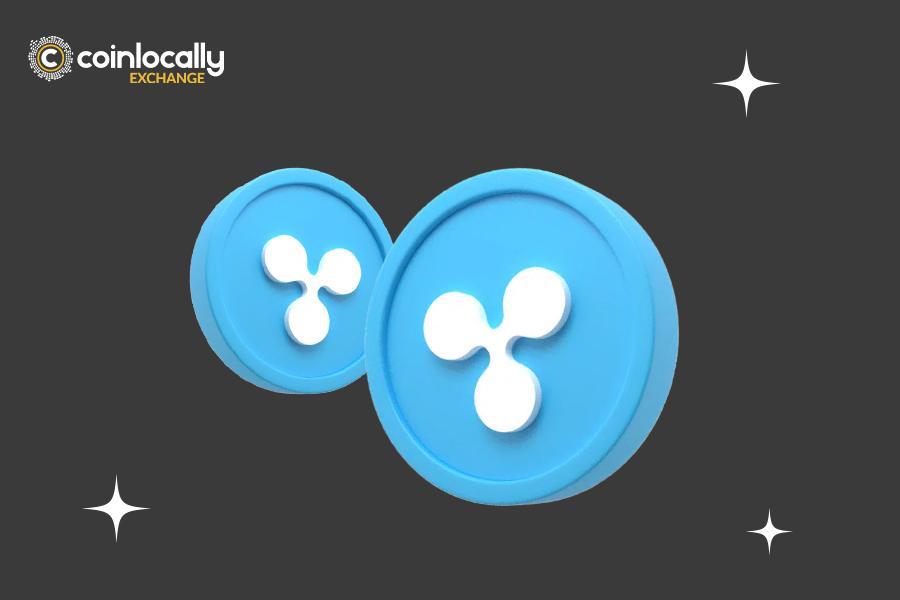Futures trading vs. Spot trading involves differences including immediate settlement at the current market price and the timing of the transaction in Spot trading while futures trading involves entering into contracts for future delivery at predetermined prices.
Quick Getaway: Looking for a safe platform that offers the most secure cryptocurrency trading platform? Signup with Coinlocally and enjoy the best Futures Trading app.
Table of Contents
• Futures Trading vs. Spot Trading: Key Differences
• Introduction to Spot Trading
• What is Leverage in Crypto Trading?
• Introduction to Futures Trading
• Similarities: Futures Trading vs. Spot trading
• Differences: Futures Trading vs. Spot Trading
• Risks: Futures Trading vs. Spot Trading
• Coinlocally’s Futures Trading vs. Spot Trading
• Futures Trading on Coinlocally
• Futures Trading vs. Spot Trading: Liquidity and Volatility
• FAQs
Futures Trading vs. Spot Trading: Key Differences
Spot trading and futures trading are two popular methods of trading financial assets. While both involve buying and selling assets, there are key differences between the two approaches. Let’s first have an introduction to these two trading features:
Introduction to Spot Trading
Buying and selling cryptos for immediate settlement is referred to as spot trading, as opposed to trading derivatives or futures contracts. It is the most prevalent method of trading in the crypto market today, and it is preferred by newcomers. Buyers and sellers agree on the current market price of a specific crypto asset in spot trading, and the transaction is resolved in real-time, with the asset moved from the seller’s wallet to the buyer’s wallet.
One of the benefits of spot trading is that it allows traders to retain actual crypto assets that can be moved to their own wallets and stored indefinitely. This is not the situation with futures or other types of derivatives trading, in which the trader merely possesses the contract rather than the underlying asset. Furthermore, spot trading is often regarded as less dangerous than trading derivatives or futures contracts because traders are not exposed to the same level of leverage and liquidation risk.
What is Leverage in Crypto Trading?
In cryptocurrency trading, leverage refers to the utilization of borrowed funds to maximize the potential return on investment. This means that traders can control a larger market position than they might with a lesser quantity of capital.
For example, a trader with $1,000 and 10x leverage can control a $10,000 stake in the market. This has the ability to increase revenues while also increasing losses. As a result, leverage is a two-edged sword that can magnify both benefits and losses. While it can boost prospective earnings, it also raises the danger of losing more than the initial investment if the deal goes against the trader’s market view.
Before utilizing leverage, traders should carefully assess their risk tolerance and trading strategy, as it can quickly lead to huge losses if not employed properly. Furthermore, traders should be aware of the costs and interest rates involved with employing leverage, as they can quickly pile up and cut into potential gains.
Introduction to Futures Trading
When comparing Futures trading vs. Spot trading in cryptocurrency, Futures trading entails the purchase and sale of contracts that bind the buyer or seller to buy or sell a crypto asset at a preset price and date in the future. This means that traders can speculate on the asset’s price without owning it. Futures trading in cryptocurrency is primarily done on centralized exchanges, with the perpetual contract, which has no expiration date, being the most frequent crypto futures contract.
One of the primary benefits of crypto futures trading is the opportunity to apply leverage, which can raise prospective profits. As previously stated, leverage is a complicated issue that may be incredibly rewarding if used correctly. This makes crypto futures trading a great tool for experienced traders wishing to speculate on the price of cryptos, but it is not suitable for beginners or those with a low-risk tolerance.
Similarities: Futures Trading vs. Spot Trading
Futures trading vs. Spot trading in cryptocurrency both entail the purchase and sale of cryptos, but they differ in terms of settlement and risk. Any transaction in spot trading is finalized instantly between the two parties, with the asset being transferred from the seller’s wallet to the buyer’s wallet.
However, there is no asset settlement in crypto futures trading, which is often eternal in nature, but rather the opening and closing of a contract on the market, which is termed open interest, and the settlement occurs in cash when the contract is closed.
Differences: Futures Trading vs. Spot Trading
Timing of Trade Execution
• Spot Trading: In spot trading, the purchase or sale of an asset occurs “on the spot” or immediately at the current market price. Settlement typically happens within a short timeframe, often within two business days.
• Futures Trading: Futures contracts involve trading an agreement to buy or sell an asset at a predetermined price and date in the future. The execution and settlement of the trade occur on a specified future date, usually months ahead.
Price Determination in Futures Trading vs. Spot Trading
• Spot Trading: The price of an asset in spot trading is determined by the current supply and demand in the market. It reflects the immediate buying and selling activity.
• Futures Trading: The price of a futures contract is based on the expected future value of the underlying asset. Factors such as supply and demand, interest rates, and market expectations influence the price.
Contract Specifications
• Spot Trading: Spot trading involves the direct exchange of the asset for cash or other agreed-upon payment methods. The terms of the transaction can be negotiated between the buyer and seller.
• Futures Trading: Futures contracts are standardized agreements traded on regulated exchanges. They have predetermined contract sizes, expiry dates, and delivery terms, making them more structured and uniform.
Margin and Leverage
• Spot Trading: Spot trading typically requires the full payment of the asset’s value at the time of the transaction. There is no margin or leverage involved, and the trader fully owns the asset.
• Futures Trading: Futures trading involves leveraging capital by paying a margin, which is a fraction of the contract’s total value. This allows traders to control a larger position than their invested capital, amplifying both profits and losses.
Purpose and Market Participants in Futures Trading vs. Spot Trading
• Spot Trading: Spot trading is commonly used for the immediate acquisition or disposal of assets. It is popular among individuals, businesses, and investors seeking ownership or quick liquidity.
• Futures Trading: Futures trading is often used for speculation, hedging, or managing risks associated with price fluctuations. It is prevalent among traders, speculators, and institutional investors seeking exposure to various asset classes.
Delivery and Settlement
• Spot Trading: In spot trading, the asset is delivered and payment is settled immediately or within a short period, as per the agreement between the buyer and seller.
• Futures Trading: Futures contracts have defined delivery and settlement dates. However, most futures traders close their positions before the contract expires, offsetting their positions without physical delivery.
Risks: Futures Trading vs. Spot Trading
Price volatility, liquidity concerns during large events, and the possibility of fraud and hacking on the project or the platform utilized for the transaction are some of the hazards connected with spot trading. However, the crypto market is still in its early phases, and as it expands and matures, these concerns will gradually fade away.
As previously said, the concept of leverage is a double-edged sword, and hence a trader must exercise extreme caution when trading in the crypto Futures markets. While debt might boost profitability, it also increases the potential risk.
Coinlocally’s Futures vs. Spot Trading
Coinlocally is a peer-to-peer cryptocurrency exchange platform that offers both futures trading and spot trading services. Here is an overview of Coinlocally’s futures and spot trading features:
Futures Trading on Coinlocally
Coinlocally’s futures trading allows users to speculate on the future price movements of cryptocurrencies through futures contracts. Traders can enter into futures positions on popular cryptocurrencies like Bitcoin, Ethereum, and other supported digital assets.
Key features of Coinlocally’s futures trading may include:
• Leverage
Coinlocally may offer leverage options, allowing traders to control larger positions with a smaller amount of capital. However, it’s important to note that leverage can amplify both potential profits and losses.
• Risk Management Tools
Coinlocally may provide risk management features such as stop-loss orders and take-profit orders to help traders manage their risk exposure.
• Multiple Contract Expirations
Traders may have access to futures contracts with different expiration dates, allowing them to choose contracts that align with their trading strategies and timeframes.
• Real-time Market Data
Coinlocally may offer real-time market data, including price charts, order books, and trading volume, to assist traders in making informed trading decisions.
• Order Types
Traders may have access to various order types, such as market orders, limit orders, and conditional orders, to execute their trading strategies effectively.
Spot Trading on Coinlocally
Coinlocally’s spot trading allows users to buy and sell cryptocurrencies for immediate settlement. In spot trading, users acquire actual ownership of the underlying cryptocurrencies they purchase.
Key features of Coinlocally’s spot trading may include:
• Wide Range of Cryptocurrencies
Coinlocally may support various cryptocurrencies, providing users with a selection of digital assets to trade.
• Order Execution
Users can place market orders or limit orders to buy or sell cryptocurrencies at the prevailing market prices or their desired price levels, respectively.
• Secure Wallet Integration
Coinlocally may offer integrated wallets for users to securely store and manage their cryptocurrencies.
• Peer-to-Peer Trading
Coinlocally operates as a peer-to-peer exchange, facilitating direct transactions between buyers and sellers.
Spot trading on Coinlocally typically involves straightforward transactions based on real-time market prices and does not involve the additional complexities of futures contracts.
Futures Trading vs. Spot Trading: Liquidity and Volatility
There are some key differences to consider in terms of liquidity and volatility for Futures trading vs. Spot trading:
• Liquidity in Futures Trading vs. Spot Trading
Spot Trading: Spot markets typically have higher liquidity compared to futures markets. This is because spot trading involves the immediate exchange of assets, and there is a constant flow of buyers and sellers in the market. As a result, it is generally easier to enter or exit positions at desired prices in spot markets.
Futures Trading: Futures markets may have lower liquidity compared to spot markets. This is because futures contracts have expiration dates, and trading volume may be concentrated in specific contract months. However, liquidity can vary depending on the specific futures contract and the overall popularity of the market. High-volume futures contracts on well-established exchanges tend to have better liquidity.
• Volatility in Futures Trading vs. Spot Trading
Spot Trading: Spot markets can experience significant volatility, driven by real-time supply and demand dynamics. Price movements in spot markets are influenced by various factors such as market news, investor sentiment, and macroeconomic events. Volatility in spot markets can present opportunities for traders to profit from price fluctuations but also carries higher risk.
Futures Trading: Futures markets can also exhibit volatility, but they may be subject to additional factors that can affect pricing. These factors include the cost of carry (the difference between the spot price and the futures price), market expectations, and the time remaining until contract expiration. Moreover, futures contracts can be leveraged, which can amplify the potential gains or losses, adding to the overall volatility of the trading instrument.
It’s important to note that Futures trading vs. Spot trading and their markets both can have liquidity and volatility, however, the specific levels may vary depending on the cryptocurrency, the exchange, and the overall market conditions. Additionally, liquidity and volatility can change over time, so it’s crucial to stay informed about the current market environment and assess the specific characteristics of each trading instrument before making trading decisions.
Traders should consider their risk tolerance, trading strategies, and objectives when choosing between spot and futures trading, taking into account factors such as liquidity, volatility, leverage, and their ability to manage risks effectively.
Conclusion
Futures trading vs. Spot trading has its advantages and considerations. Spot trading offers immediate ownership of the underlying asset, while futures trading provides opportunities for speculation, hedging, and leveraging positions. The choice between the two depends on an individual’s trading objectives, risk tolerance, and preferred trading strategies.
FAQs
• Which market has higher liquidity, spot, or futures?
Generally, in Futures trading vs. Spot trading, spot markets have higher liquidity compared to futures markets. Spot markets involve the direct exchange of assets, attracting a continuous flow of buyers and sellers. Futures markets may have lower liquidity, particularly in less actively traded contracts or during periods of low trading activity.
• Are spot markets more volatile than futures markets?
Spot markets can exhibit significant volatility due to real-time supply and demand dynamics, market news, and other factors. Futures markets can also experience volatility, influenced by factors such as cost of carry, time to contract expiration, and market expectations. Both markets can have periods of high volatility, but the nature of volatility may differ.
• Which trading method is better for short-term trading?
Short-term trading is more commonly associated with spot trading due to its immediate settlement and higher liquidity. Traders can quickly enter and exit positions at current market prices in spot markets, which is advantageous for short-term strategies.
• Can I use leverage in spot trading?
Leverage is not typically available in spot trading. It is more commonly associated with futures trading, where traders can control larger positions with a smaller amount of capital. Spot trading involves the direct ownership of assets without the use of leverage.
• What are some risk management considerations in futures trading?
Futures trading involves leverage and can amplify both potential profits and losses. Traders should carefully consider their risk tolerance, set appropriate stop-loss orders, and employ risk management strategies, such as diversification and position sizing, to mitigate potential losses.
• Can I hedge my positions in both spot and futures markets?
Hedging involves taking offsetting positions to mitigate potential losses. While both spot and futures markets can offer hedging opportunities, futures markets are more commonly used for hedging due to their ability to lock in future prices and manage risk exposures.
• Can I trade both Spot and Futures on the same platform?
Some platforms offer both spot and futures trading services, allowing traders to access both markets from a single platform. However, it’s important to check the specific offerings of each platform to ensure they provide the desired trading options.





